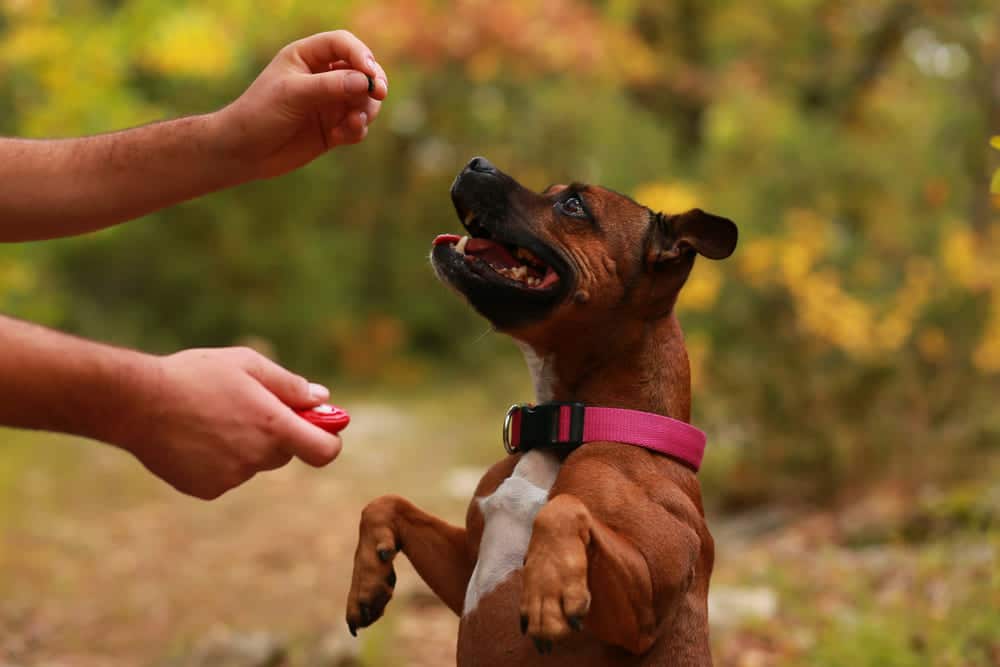Using clicker training is a great technique to help your dog focus on the task at hand. During training, you can utilize a clicker to assist your dog in identifying when they have performed a behavior that will result in a reward. So, in this article, let’s know about clicker training.
Here’s a detailed description of clicker training, with key takeaways derived from the provided text:
What is Clicker Training?
- Precision Tool: Clicker training builds on positive reinforcement principles, but the clicker is an exact marker of the desired behavior.
- Clear Communication: The clicker creates clear communication with your dog, eliminating the guesswork of when a treat is coming and why.
- Not Just for Commands: Clicker training can teach tricks, shape calm behavior, and modify reactions in challenging situations.
How Clicker Training Works
- “Loading” the Clicker: Through repeated pairings of a click followed immediately by a treat, your dog learns the clicker = good things are coming!
- Marking the Moment: Once the clicker is associated with rewards, you use it to pinpoint the exact moment your dog does the right thing.
- Reward and Repeat: The click is always followed by a reward (treat, play, praise), strengthening the association between the behavior and positive consequences.
How to Get Started with Clicker Training
- Quiet Setting: Begin in a low-distraction environment to set your dog up for success.
- Practice the Click/Treat: Repeatedly click, then immediately give a treat. Your dog will quickly learn the association.
- Test the Connection Click when your dog isn’t expecting it. If it looks at you excitedly, they have understood the concept!
- Introduce Commands: Click at the exact moment your dog performs the desired action (ex: the moment their butt hits the floor in a “sit”). Follow with a treat.
- Shape Behaviors: Clicker training is excellent for shaping complex behaviors by rewarding small steps toward the final goal.
Key Takeaways
- Timing is Everything: The click must happen at the precise moment of the desired action to be effective.
- Consistency is Key: Click and treat every time they perform the correct behavior to solidify the learning.
- Treats Matter: Use high-value treats to keep your dog motivated.
- Beyond Basic Commands: Clicker training is versatile for teaching tricks, calm behavior in difficult situations, and much more.
Additional Tips
- Keep Sessions Short: Several short sessions are better than one long session.
- Gradually Increase Difficulty: Start in a quiet place and slowly introduce distractions as your dog masters the basics.
.
What Is Clicker Training?
Positive reinforcement and clicker training are identical, except clicker training has an additional advantage. All that a clicker is is a little mechanical noisemaker.
The methods are founded in the science of animal learning, which holds that rewarding behaviors increase their likelihood of recurrence in the future.
Therefore, clicker training reverses the script and focuses on what your dog is doing correctly instead of focusing on what your dog is not doing well and taking good behavior for granted. If you teach your dog what to do rather than what not to do, you can significantly influence its behavior.
The clicker is useful because it indicates to your dog precisely which behavior is being rewarded. By clicking at the appropriate time, you can “mark” the exact instant your dog performed what you wanted.
With a click, your dog can tell what they did right instead of having to guess. When teaching a dog to sit, for instance, you would click as soon as the dog’s butt touched the floor.
How Does the Click Signify?
The clicker serves only as a moment marker. That particular noise isn’t remarkable, except that you probably never use it around your dog outside of training.
As a result, you can use anything as a marker as long as it’s different from other ways you and your dog communicate.
For instance, you could cluck your tongue, snap your fingers, or blow a whistle. A marker word like “Yes” or “Good” is frequently used. You may give a dog with hearing loss a quick, light tap on the shoulder.
Naturally, a click or other marker is useless by itself unless it is combined with an incentive. All the click does is signal that a reward is on its way.
Food treats work best for most dogs as an incentive, but anything your dog values can serve as a reward. Thus, play tug-of-war with your dog if he would rather work for that than a piece of chicken.
Timing and consistency are vital components. Every click must result in a reward, and the click must indicate the exact moment.
How To Use Clicker In Dog Training?
It would help if you first taught the dog what the marker implies before using a clicker or other marking device. Often referred to as “loading the clicker,” you associate a reward with the marker of your choice. Click now, then start treating right now. Your dog will eventually comprehend that the marker indicates an impending reward after 10 to 20 repetitions. It’s now time for you to use the clicker.
You can use your marker using lure-and-reward training, which involves using a reward to entice your dog to perform the desired behavior.
However, it also helps to mold behavior. Shaping is the process of gradually developing a complex behavior. Another excellent tool for capturing positive behavior is the clicker. Thus, click to encourage your dog to lie calmly on a mat rather than pleading at the table.
If your dog is on the floor with all four paws when the doorbell rings, click instantly to prevent your dog from jumping on visitors. Clicker training is also an excellent method of teaching stunts.
Once your dog has mastered a new behavior, you won’t need the marker anymore. It is only a teaching tool, after all. However, a clicker or other marker will let you clearly communicate with your dog whenever you wish to lure, shape, or capture a behavior to get what you want.
- Begin in a Quiet Environment
Start with your dog in a distraction-free, peaceful environment. This training should ideally take place when your dog is hungry. A few of your dog’s favorite treats and the clicker should be ready.
- Presenting the Clicker
Hit the clicker. As soon as the clicker is activated, give your dog a treat. Repeat this click/treat combo five to ten times.
- Examine Your Dog
When your dog is not looking at you, you can click to see how well you’re doing. You can proceed if your dog looks at you abruptly after hearing the click and then searches for a treat. If not, keep doing the click-reward sequence until your dog understands that a treat is always included.
- To access Basic Commands, Click.
Use the clicker to teach your dog some simple commands. Click the clicker at the precise moment your dog demonstrates the desired behavior.
Give a reward and some praise afterward. If you don’t click at the appropriate moment, your dog will become confused and unaware of what behavior earned the treat.
Accuracy is among the clicker’s best features. The dog links what it does to the click and the reward.
This helps the dog understand what it is doing better and increases the likelihood that your dog will repeat the activity when asked to do so.
- Proceed to More Advanced Clicker Training:
Clicker training can also be beneficial for more advanced training. “You simply click for small steps towards the behavior and work the dog towards the final, completed behavior,” Walker explains. “You can now take a backseat (apart from giving the prize, of course).
The dog doesn’t need to be coerced into a posture, which frequently slows down the procedure.” The clicker is a handy teaching tool.
Consider utilizing the clicker while designing an obedience and training regimen for your dog, and observe how effective the technique is for yourself.
Conclusion:
It is also crucial to maintain consistency in your clicking style. We suggest holding your clicker at the side of your body, in the palm of your hand. Holding your clicker like a remote and pointing it at your dog can be daunting.
“Understanding the nuances of effective training techniques is essential for any learning process, for humans or animals. In pet care, Dog Training (Course) is particularly vital as it shapes obedient behavior and fosters a bond between the pet and its owner. It offers an extensive, cost-effective course, with the entire course priced at just the equivalent of what a dog trainer might charge for a single hour ($40 to $120). It covers many behaviors, including Potty Training, Lunging, Jumping, Digging, Whining, Chewing, Excessive Barking, Impulse Control, Hyperactivity, Ignoring Commands, and more. Plus, they provide a 100% money-back guarantee if you cancel within 60 days, ensuring your investment is risk-free.”


